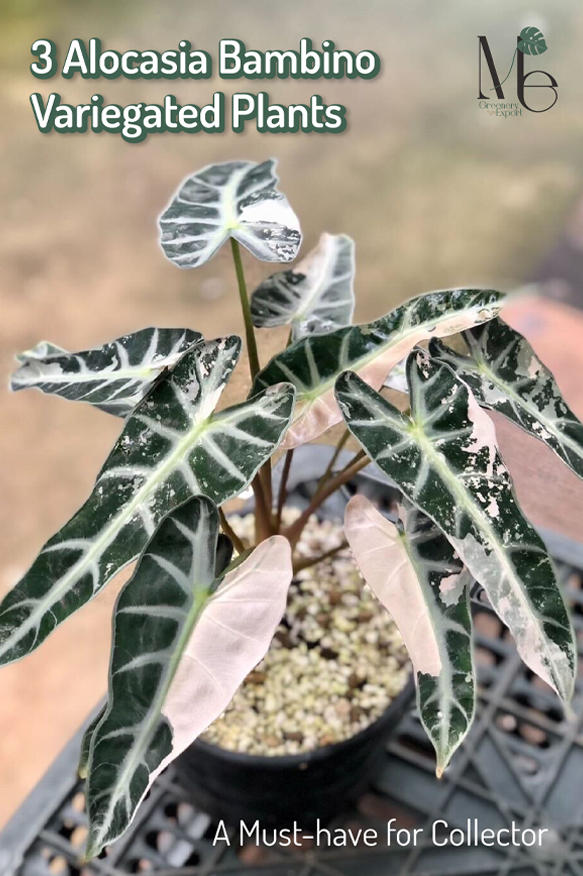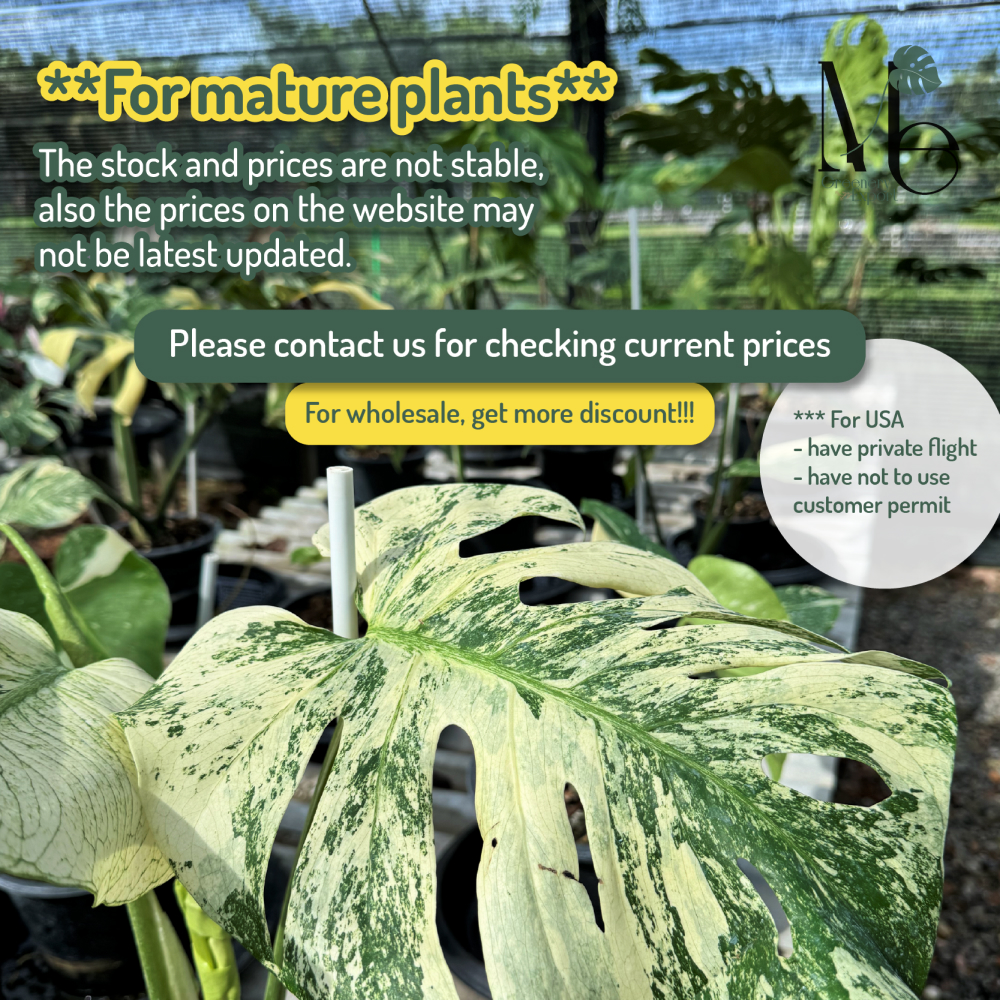No products in the cart.
3 Alocasia Bambino Variegated Plants, a Must-have for Collector
DATE : August 28, 2024 By : admin
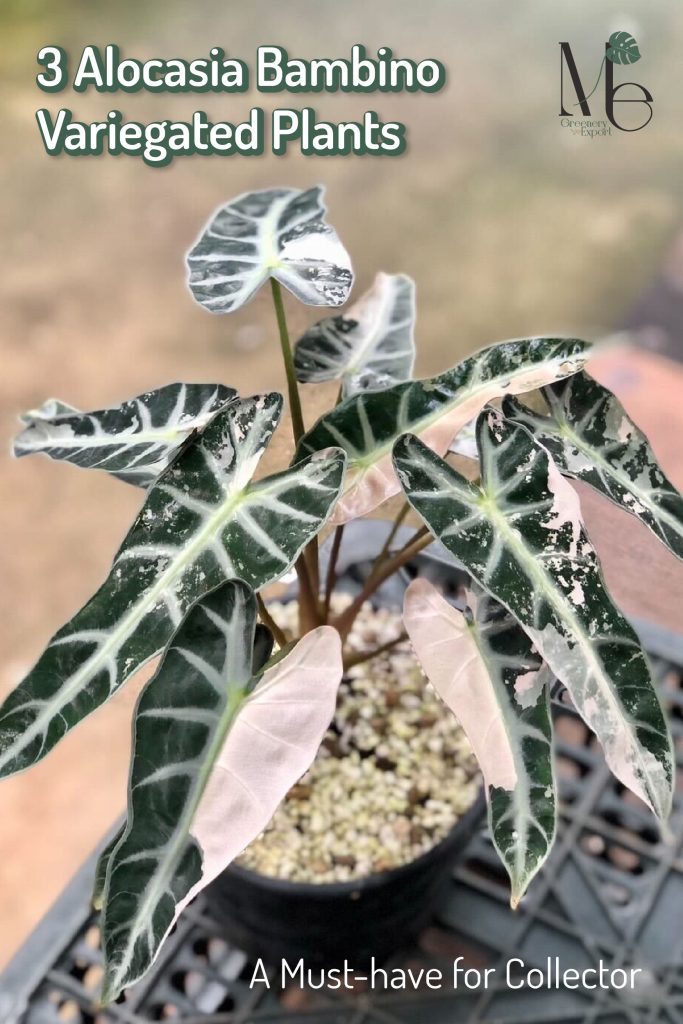
Calling all big fans of Alocasia Bambino Variegated! This stunning plant is one of the most popular Alocasias due to its beautiful appearance and variety of species. People love to collect Alocasia Bambino Variegated because it comes in white, pink, and yellow variegated varieties. If you are wondering how these are different, we have got you covered. Today, we will introduce “3 Alocasia Bambino Variegated Plants, a Must-have for Collectors” to clear up any doubts. If you are ready to learn more about Alocasia Bambino Variegated, let’s dive in!
Alocasia Bambino Variegated
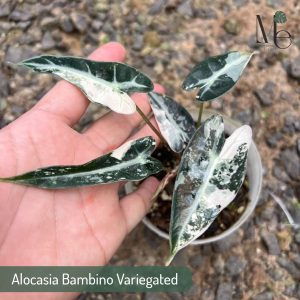
The elegant Alocasia Bambino Variegated, a beloved member of the Alocasia plant family. For enthusiasts looking to expand their collection with Variegated Alocasias, this particular variety is an excellent choice. If you’re intrigued and eager to learn more, let’s explore the unique characteristics of the Alocasia Bambino Variegated together.
-
This plant is a member of the Araceae family
The Alocasia Bambino Variegated is a proud member of the Araceae family along with many other alocasias.
-
Native to Southeast Asia and Eastern Australia
Since the Alocasia Bambino Variegated is native to tropical areas, it thrives in warm and humid conditions.
-
The name “Alocasia” is derived from Greek.
The name Alocasia comes from the Greek word “A” meaning “without” and the word “Colocasia,” which is the genus name of the tree. The two words combine to form “Alocasia,” meaning “not colocasia”.
-
It is a small air-purifying plant
This alocasia is an air-purifying plant that does not exceed 40 centimeters in size. It can be planted to trap dust and prevent air pollution.
-
It is a white variegated plant
The Alocasia bambino possesses strikingly slender, deep green leaves adorned with contrasting silver veins. The addition of white flecks further elevates its allure, giving the leaves a glossy, three-dimensional appearance
-
It thrives in warm and humid weather
Because it is native to tropical rainforests, this plant thrives in warm and humid conditions. It should be positioned in a bright area but shielded from direct sunlight to prevent leaf scorching. To avoid waterlogging and root rot, it is important to use planting materials that drain water effectively while retaining moisture. Some recommended planting materials are:
1. Ready-made soil

The soil mixture can be used for planting, but some plants need extra nutrients, so it is important to mix in additional materials like perlite, vermiculite, and raintree leaves. If you prefer a crumbly texture, you can also add volcanic rocks.
2. Raintree leaves

The leaves of the raintree are rich in nitrogen, providing nourishment for the trunk and leaves, and can fulfill the needs of almost any plant. Additionally, they decompose slowly and help maintain the soil.
3. Chopped coconut husks/Coconut coir
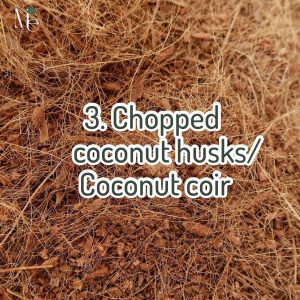
Coconut coir is derived from shredded coconut husks, retaining moisture effectively. When mixed with soil, it increases soil aeration, making it more translucent.
4. Perlite
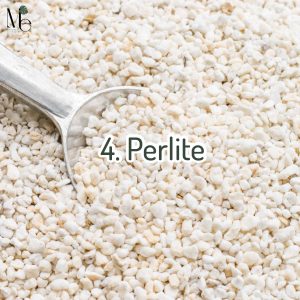
Perlite is a mineral extracted from volcanic rocks. It is lightweight, porous, and retains moisture and nutrients well due to its high porosity. It is commonly used in conjunction with vermiculite as a planting material.
5. Vermiculite
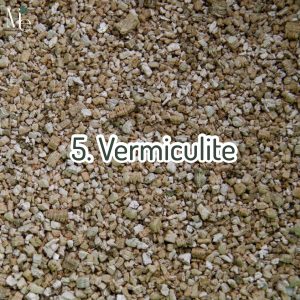
Vermiculite is a highly effective lightweight mineral that significantly absorbs water, retains moisture, and provides essential nutrients such as phosphorus, potassium, magnesium, and calcium for plant growth. Additionally, it plays a crucial role in balancing ion exchange within the soil.
By consistently following these steps, you will ensure that your Alocasia Bambino Variegated becomes a beautiful and admirable addition to your home.
Alocasia Bambino Pink Variegated
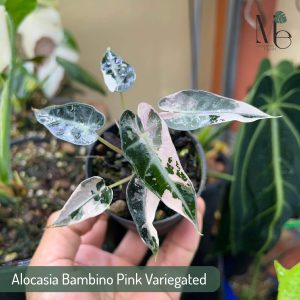
When discussing Alocasia Bambino Variegated, it’s impossible to overlook its cousin, Alocasia Bambino Pink Variegated. However, due to genetic and environmental changes, the plant develops a pink color, which primarily occurs in cold weather. This is the reason why it stands out with its pink variegation, making it even more unique than its white-variegated counterpart. Are you curious about the Alocasia Bambino Pink Variegated? If so, let’s delve into its unique characteristics.
-
This plant is a member of the Araceae family
The Alocasia Bambino Pink Variegated is a stand-out member of the Araceae family along with many other alocasias.
-
Native to Southeast Asia
Alocasia Bambino Pink Variegated thrives in warm and humid weather since it is native to Southeast Asia, where the climate is hot and humid, making it a source of many beautiful plants.
-
The name “Alocasia” is derived from Greek.
The name Alocasia comes from the Greek word “A” meaning “without” and the word “Colocasia,” which is the genus name of the tree. The two words combine to form “Alocasia,” meaning “not colocasia.”
-
It is a rare plant
Genetic variation gives rise to the rarity of Alocasia Bambino Pink Variegated, making it a unique and prized plant.
-
It is a pink-variegated plant
Alocasia Bambino Pink Variegated stands out with its beautiful pastel pink variegated leaves and nurturing pink leaf stalks. Introducing these plants into your home will certainly liven up your living space.
-
It thrives in warm and humid weather
As a tropical rainforest plant, it thrives in warm and humid conditions. It should be placed in a well-lit area but not in direct sunlight as this can cause the leaves to burn. Water it regularly when the soil starts to dry out. To prevent root rot, use planting media that drains water well and retains moisture. Some popular planting materials include:
-
Ready-made soil

The soil mixture can be used for planting, but some plants need extra nutrients, so it is important to mix in additional materials like perlite, vermiculite, and raintree leaves. If you prefer a crumbly texture, you can also add volcanic rocks.
-
Raintree leaves

The leaves of the raintree are rich in nitrogen, providing nourishment for the trunk and leaves, and can fulfill the needs of almost any plant. Additionally, they decompose slowly and help maintain the soil.
-
Chopped coconut husks/Coconut coir

Coconut coir is derived from shredded coconut husks, retaining moisture effectively. When mixed with soil, it increases soil aeration, making it more translucent.
-
Perlite

Perlite is a mineral extracted from volcanic rocks. It is lightweight, porous, and retains moisture and nutrients well due to its high porosity. It is commonly used in conjunction with vermiculite as a planting material.
-
Vermiculite

Vermiculite is a highly effective lightweight mineral that significantly absorbs water, retains moisture, and provides essential nutrients such as phosphorus, potassium, magnesium, and calcium for plant growth. Additionally, it plays a crucial role in balancing ion exchange within the soil.
That’s it, and your stunning Alocasia Bambino Pink Variegated is prepared to dazzle alongside the Alocasia plants.
Alocasia Bambino Aurea
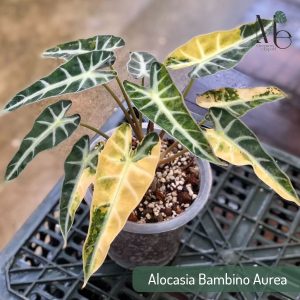
We have reached the final Alocasia Bambino Variegated, known as “Alocasia Bambino Aurea”. This particular Alocasia is highly sought after due to its exceptionally rare yellow variegation. Curious about its quality? Let’s take a closer look and find out.
-
This plant is a member of the Araceae family
The Alocasia Bambino Aurea is a sought–after member of the Araceae family along with many other alocasias.
-
Native to Southeast Asia
Alocasia Bambino Aurea, a plant native to Southeast Asia, thrives in hot and humid weather, producing beautiful foliage.
-
The name “Alocasia” is derived from Greek.
The name Alocasia comes from the Greek word “A” meaning “without” and the word “Colocasia,” which is the genus name of the tree. The two words combine to form “Alocasia,” meaning “not colocasia.”
-
It is a rare plant
The Alocasia Bambino Aurea is a rare and highly sought-after plant, just like the Alocasia Bambino Pink Variegated. Both of these plants are quite scarce in the market, making them prized possessions for plant enthusiasts. If you have a penchant for rare Alocasia species, the Alocasia Bambino Aurea is a perfect addition to your collection.
-
It is a yellow variegated plant
The Alocasia Bambino Aurea is a stunning plant with vibrant yellow variegation adorning its glossy green leaves. Delicate white veins run through the leaves, creating a mesmerizing pattern. Incorporating this plant into your home decor will infuse your space with a burst of cheerful yellow, banishing any hint of monotony.
-
It thrives in warm and humid weather
Due to its origins in tropical rainforests, this plant flourishes in warm and humid conditions. It’s essential to maintain a warm and humid environment to ensure its well-being. When choosing a spot for the plant, opt for a bright location, but be mindful to avoid direct sunlight, as this can lead to leaf scorching. Regular watering is key; ensure to water the plant when the soil begins to dry out. To guard against root rot, it’s advisable to use planting media with excellent drainage and moisture retention. You may consider using materials such as:
- Ready-made soil

The soil mixture can be used for planting, but some plants need extra nutrients, so it is important to mix in additional materials like perlite, vermiculite, and raintree leaves. If you prefer a crumbly texture, you can also add volcanic rocks.
- Raintree leaves

The leaves of the raintree are rich in nitrogen, providing nourishment for the trunk and leaves, and can fulfill the needs of almost any plant. Additionally, they decompose slowly and help maintain the soil.
- Chopped coconut husks/Coconut coir

Coconut coir is derived from shredded coconut husks, retaining moisture effectively. When mixed with soil, it increases soil aeration, making it more translucent.
- Perlite

Perlite is a mineral extracted from volcanic rocks. It is lightweight, porous, and retains moisture and nutrients well due to its high porosity. It is commonly used in conjunction with vermiculite as a planting material.
- Vermiculite

Vermiculite is a highly effective lightweight mineral that significantly absorbs water, retains moisture, and provides essential nutrients such as phosphorus, potassium, magnesium, and calcium for plant growth. Additionally, it plays a crucial role in balancing ion exchange within the soil.
By tending to it with regular love and care, you’ll soon marvel at the stunning leaves of the Alocasia Bambino Aurea.
How about the “3 Alocasia Bambino Variegated Plants, a Must-have for Collector” we introduced? Basically, the Alocasia Bambino Variegated plants are not very different from each other. However, the unique color of their variegated spots sets them apart, making certain varieties more elusive to find than others. Finally, if you are interested in Alocasia Bambino Variegated tc, Alocasia Bambino Pink Variegated tc, and Alocasia Bambino Aurea tc but are still hesitant or have a question, we are happy to advise and export the best quality plants from Thailand to you every season.
See you again on the following topic, bye<3
References:
- Alocasia Bambino 100% Variegated (TC) – M.E. Greenery Export
- Alocasia Bambino Pink Variegated (TC) – M.E. Greenery Export
- Alocasia Bambino Aurea Variegated (TC) – M.E. Greenery Export
- Alocasia Bambino Aurea, a Decorative Plant Suitable for Growing Indoors
- “Alocasia Bambino Var.”, the Charming Air-Purifying Plant

